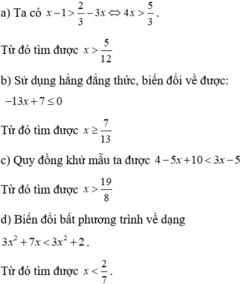3x2 (2x- 1)+ 1- 4x2 0
Hãy nhập câu hỏi của bạn vào đây, nếu là tài khoản VIP, bạn sẽ được ưu tiên trả lời.


1) Ta có: \(2x\left(x-3\right)+5\left(x-3\right)=0\)
\(\Leftrightarrow\left(x-3\right)\left(2x+5\right)=0\)
\(\Leftrightarrow\left[{}\begin{matrix}x=3\\x=-\dfrac{5}{2}\end{matrix}\right.\)
2) Ta có: \(\left(x^2-4\right)-\left(x-2\right)\left(3-2x\right)=0\)
\(\Leftrightarrow\left(x-2\right)\left(x+2\right)+\left(x-2\right)\left(2x-3\right)=0\)
\(\Leftrightarrow\left(x-2\right)\left(3x-1\right)=0\)
\(\Leftrightarrow\left[{}\begin{matrix}x=2\\x=\dfrac{1}{3}\end{matrix}\right.\)
3) Ta có: \(\left(2x-1\right)^2-\left(2x+5\right)^2=11\)
\(\Leftrightarrow4x^2-4x-1-4x^2-20x-25=11\)
\(\Leftrightarrow-24x=11+1+25=37\)
hay \(x=-\dfrac{37}{24}\)
5) Ta có: \(3x^2-5x-8=0\)
\(\Leftrightarrow3x^2+3x-8x-8=0\)
\(\Leftrightarrow3x\left(x+1\right)-8\left(x+1\right)=0\)
\(\Leftrightarrow\left(x+1\right)\left(3x-8\right)=0\)
\(\Leftrightarrow\left[{}\begin{matrix}x=-1\\x=\dfrac{8}{3}\end{matrix}\right.\)
8) Ta có: \(\left|x-5\right|=3\)
\(\Leftrightarrow\left[{}\begin{matrix}x-5=3\\x-5=-3\end{matrix}\right.\Leftrightarrow\left[{}\begin{matrix}x=8\\x=2\end{matrix}\right.\)
10) Ta có: \(\left|2x+1\right|=\left|x-1\right|\)
\(\Leftrightarrow\left[{}\begin{matrix}2x+1=x-1\\2x+1=1-x\end{matrix}\right.\Leftrightarrow\left[{}\begin{matrix}2x-x=-1-1\\2x+x=1-1\end{matrix}\right.\)
\(\Leftrightarrow\left[{}\begin{matrix}x=-2\\x=0\end{matrix}\right.\)

\(a,\Rightarrow x^3+9x^2+27x+27-9x^3-6x^2-x+8x^3+1-3x^2=54\\ \Rightarrow26x=26\Rightarrow x=1\\ b,\Rightarrow x^3-9x^2+27x-27-x^3+27+6x^2+12x+6+3x^2=-33\\ \Rightarrow39x=-39\Rightarrow x=-1\)

a) Ta có: \(\left(3x^2-2x+5\right)-\left(x^2+4x^2-x-7\right)\)
\(=3x^2-2x+5-5x^2+x+7\)
\(=-2x^2-x+12\)
b) Ta có: \(4\left(2x+1\right)-5\left(3x+2\right)\)
\(=8x+4-15x-10\)
=-7x-6

\(\dfrac{A}{2x-1}=\dfrac{6x^3+3x^2}{4x^2-1}\Leftrightarrow\dfrac{A}{2x-1}=\dfrac{3x^2\left(2x+1\right)}{\left(2x-1\right)\left(2x+1\right)}\Leftrightarrow\dfrac{A}{2x-1}=\dfrac{3x^2}{2x-1}\Leftrightarrow A=3x^2\)
Ta có: \(\dfrac{A}{2x-1}=\dfrac{6x^3+3x^2}{4x^2-1}\)
\(\Leftrightarrow\dfrac{A}{2x-1}=\dfrac{3x^2\left(2x+1\right)}{\left(2x+1\right)\left(2x-1\right)}\)
\(\Leftrightarrow\dfrac{A}{2x-1}=\dfrac{3x^2}{2x-1}\)
hay \(A=3x^2\)


![]()
⇔ 4x - 10 = 2 - x
⇔ 4x + x = 2 + 10 ⇔ 5x = 12 ⇔ x = 12/5
Vậy: S = {12/5}
b) (3x + 1) = (3x + 1)2
⇔ (3x + 1)2 - (3x + 1) = 0
⇔ (3x + 1)[(3x + 1) - 1] = 0


ĐKXĐ:x ≠ 1
Quy đồng mẫu hai vế của phương trình ta được:

Khử mẫu hai vế, ta được:
(2x + 3)(x - 1) + 2(x2 + x + 1) = 4x2 - 1
⇔ 2x2 + x - 3 + 2x2 + 2x + 2 = 4x2 - 1
⇔ 3x - 1 = -1
⇔ 3x = 0 ⇔ x = 0 (thỏa mãn điều kiện)
Vậy: S = {0}

a) (2x – 1)(4x2 + 2x + 1) – 4x(2x2 – 3) = 23
⇔ 8x3 – 1 – 8x3 + 12x = 23
⇔ 12x = 24 ⇔ x = 2.
Tập nghiệm của phương trình: S = {2}
b) ĐKXĐ : x + 1 ≠ 0 và x – 2 ≠ 0 (vì vậy x2 – x – 2 = (x + 1)(x – 2) ≠ 0)
⇔ x ≠ -1 và x ≠ 2
Quy đồng mẫu thức hai vế :

Khử mẫu, ta được : x2 – 4 – x – 1 = x2 – x – 2 – 3 ⇔ 0x = 0
Phương trình này luôn nghiệm đúng với mọi x ≠ -1 và x ≠ 2.

Bài 1:
a) (3x - 2)(4x + 5) = 0
<=> 3x - 2 = 0 hoặc 4x + 5 = 0
<=> 3x = 2 hoặc 4x = -5
<=> x = 2/3 hoặc x = -5/4
b) (2,3x - 6,9)(0,1x + 2) = 0
<=> 2,3x - 6,9 = 0 hoặc 0,1x + 2 = 0
<=> 2,3x = 6,9 hoặc 0,1x = -2
<=> x = 3 hoặc x = -20
c) (4x + 2)(x^2 + 1) = 0
<=> 4x + 2 = 0 hoặc x^2 + 1 # 0
<=> 4x = -2
<=> x = -2/4 = -1/2
d) (2x + 7)(x - 5)(5x + 1) = 0
<=> 2x + 7 = 0 hoặc x - 5 = 0 hoặc 5x + 1 = 0
<=> 2x = -7 hoặc x = 5 hoặc 5x = -1
<=> x = -7/2 hoặc x = 5 hoặc x = -1/5

\(3x^2\left(2x-1\right)+1-4x^2=0\)
\(\Leftrightarrow3x^2\left(2x-1\right)-\left(2x+1\right)\left(2x-1\right)=0\)
\(\Leftrightarrow\left(3x^2-2x-1\right)\left(2x-1\right)=0\)
\(\Leftrightarrow\left(3x+1\right)\left(x-1\right)\left(2x-1\right)=0\)
\(\Leftrightarrow x=\frac{-1}{3};x=1;x=\frac{1}{2}\)